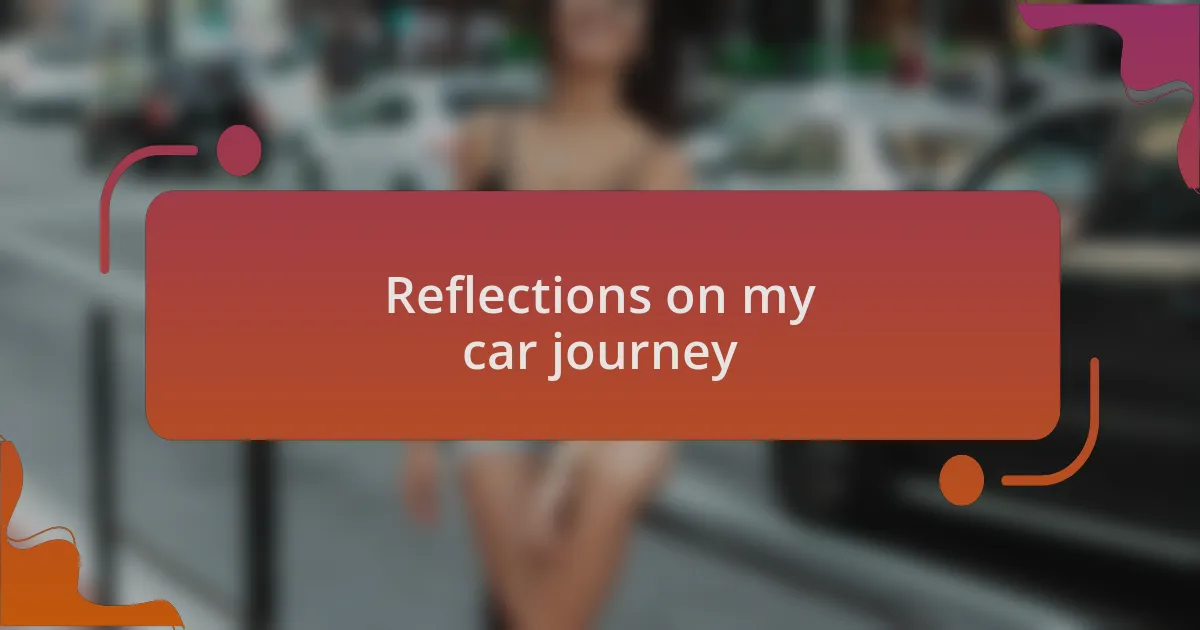Key takeaways:
- Vintage car expos provide a space for enthusiasts to connect, share stories, and gain knowledge about classic automobiles and their history.
- Documenting car journeys enhances the experience, transforms memories into stories, and assists with restoration and maintenance efforts.
- Effective car showcasing involves attention to lighting, interior presentation, and storytelling to engage potential admirers.
- Sharing experiences online fosters community, sparks conversations, and allows for the exchange of personal narratives among car enthusiasts.

Understanding vintage car expos
Attending a vintage car expo is not just about admiring classic automobiles; it’s about immersing oneself in a community filled with a shared passion for history and craftsmanship. I remember my first expo vividly, standing awestruck before a gleaming 1967 Ford Mustang. The air buzzed with excitement as enthusiasts shared stories, and I felt an immediate connection to a larger narrative that transcended generations.
These expos often feature not only displays of stunning vehicles but also workshops and talks from seasoned collectors, offering insights that can deepen your appreciation for these mechanical marvels. I still recall a passionate lecture from a restoration expert who illustrated the painstaking process of bringing a car back to life—it left me inspired and hungry for knowledge. Have you ever found yourself in a situation where you realize how much you can learn from those who have been in the hobby much longer than you?
In essence, vintage car expos serve as a rewarding gathering place, merging nostalgia with education. It’s a chance to celebrate not just the vehicles themselves, but the stories they carry. As I browsed through rows of polished chrome and vibrant paint, I couldn’t help but wonder—what untold adventures had these cars experienced before they reached the expo? Each vehicle was a chapter in a much larger book, ready to be discovered by enthusiasts like me.

Importance of documenting car journeys
Documenting car journeys holds significant importance for any vintage car enthusiast. Through my own experiences, I’ve found that capturing the details of each trip transforms mere memories into stories that can be revisited and shared. I often look back at my notes from a road trip along the Pacific Coast Highway; not only did I document the scenic views, but I also recorded every pit stop, each conversation I had with fellow car lovers, and the sense of freedom that came with the open road. How many moments like this can slip away if we don’t take the time to write them down?
Moreover, having a detailed account of your journeys can serve as an invaluable resource for restoration and maintenance. I learned this firsthand when I had to source replacement parts for my 1970 Chevrolet Camaro. My careful documentation included notes on the challenges I faced during previous repairs and tips I picked up from conversations at car meets. Reflecting on these records made the process less daunting and allowed me to connect with others who had similar challenges. Have you ever struggled to recall what worked well in the past?
Lastly, documenting these experiences fosters a deeper connection to the car itself. When I look back through my journey records, it’s like I’m reuniting with an old friend. The quirks and highlights I noted remind me of the joy the car has brought me, transforming it from a mere vehicle to a beloved companion. It raises an amusing thought: wouldn’t it be fun if our classic cars could talk and share their versions of the adventures we’ve had together?

Tips for showcasing your car
When showcasing your classic car, lighting plays a crucial role. I remember preparing for a local vintage car show and realizing that the way I positioned my 1969 Mustang made all the difference. I opted for a shaded area under a tree, which not only highlighted its glossy paint but also drew people in, creating a natural, inviting atmosphere. How do you handle lighting for your vintage vehicle displays?
Another key aspect is the presentation of your car’s interior. During a recent meetup, I made a point to polish the dashboard and clean the upholstery before the event. I noticed that potential buyers and enthusiasts were more drawn to the car when they could see how well it was cared for inside. It’s amazing how a little effort in tidying up can enhance the overall impression. Have you thought about what little details might impress onlookers?
Don’t underestimate the power of storytelling when showcasing your car. At a recent expo, I shared the history of my 1965 Corvair, from its original owner to the restoration journey. This personal connection sparked conversations, turning casual viewers into engaged listeners. It’s fascinating how a good story can transform mere interest into genuine admiration. What tales does your classic car carry that are waiting to be told?

Capturing the perfect car photos
Finding the right angle can make a significant difference in how your car is perceived in photographs. I recall a day when I climbed up on a nearby hill to capture my friend’s 1957 Chevy Bel Air against the sunset. The resulting shots, with the vibrant colors reflecting off the classic curves, took my breath away. Have you explored unique vantage points when photographing your cherished vehicle?
Another element that elevates your car photography is the background. I’ve learned to look for settings that complement the car’s character. For instance, I once took pictures of my 1968 Camaro in front of an old brick wall adorned with graffiti, which not only added depth but also conveyed a story. How do you choose locations that reflect your car’s personality?
Lastly, don’t be afraid to experiment with different settings on your camera. During one photo session, I switched to a lower aperture setting and achieved a dreamy background blur that made my 1970 Dodge Challenger pop. It was an exciting moment to see how simple changes could turn an ordinary shot into an extraordinary one. What camera techniques have you found transformative in your car photography?

Sharing your journey online
Sharing your classic car journey online can be incredibly rewarding. I remember the first time I posted about my restoration of a 1965 Ford Mustang. The engagement was overwhelming! Comments and questions flooded in, making me realize I wasn’t just sharing pictures—I was sparking conversations and building connections with fellow enthusiasts. Have you noticed how sharing a personal narrative can inspire others to share their own stories?
Social media platforms provide the perfect canvas to showcase this passion. When I created a dedicated Instagram account for my vintage cars, it felt like opening a window into my world. Not only did I document each milestone, from sourcing hard-to-find parts to the exhilarating first drive, but I also found a community that thrives on nostalgia and pride. How has connecting with like-minded individuals enriched your own experiences?
Beyond just sharing photos, storytelling is crucial. I often craft posts that delve into the history of each car, sharing the quirks and challenges I faced during restoration. I remember detailing how I sourced an original part for my 1972 Volkswagen Beetle—it took months of searching, but each success felt like a small victory. How do you weave stories into your posts to captivate your audience?

Reflections on my car journey
Reflecting on my classic car journey brings a mix of joy and nostalgia. I often think about the first time I laid eyes on my 1967 Chevrolet Camaro. The thrill of that moment was palpable, and it sparked a passion that has never waned. Have you ever experienced that indescribable feeling when you first connect with a car? It’s more than just metal and wheels—it feels like meeting an old friend.
As I navigated through the restoration process, there were moments of frustration that tested my patience. I remember struggling with the paint job; it didn’t turn out right the first time, and I felt disheartened. But looking back, those challenges only deepened my appreciation for the finished product. Have you had similar experiences where setbacks ultimately enriched your journey?
The journey has also been as much about personal growth as it has been about cars. I’ve learned to be resourceful, often reaching out to fellow enthusiasts for advice when I hit roadblocks. Those interactions not only helped me improve my skills but also reminded me of the beauty of community. Don’t you find that sharing struggles can foster deeper connections with others who share your passion?